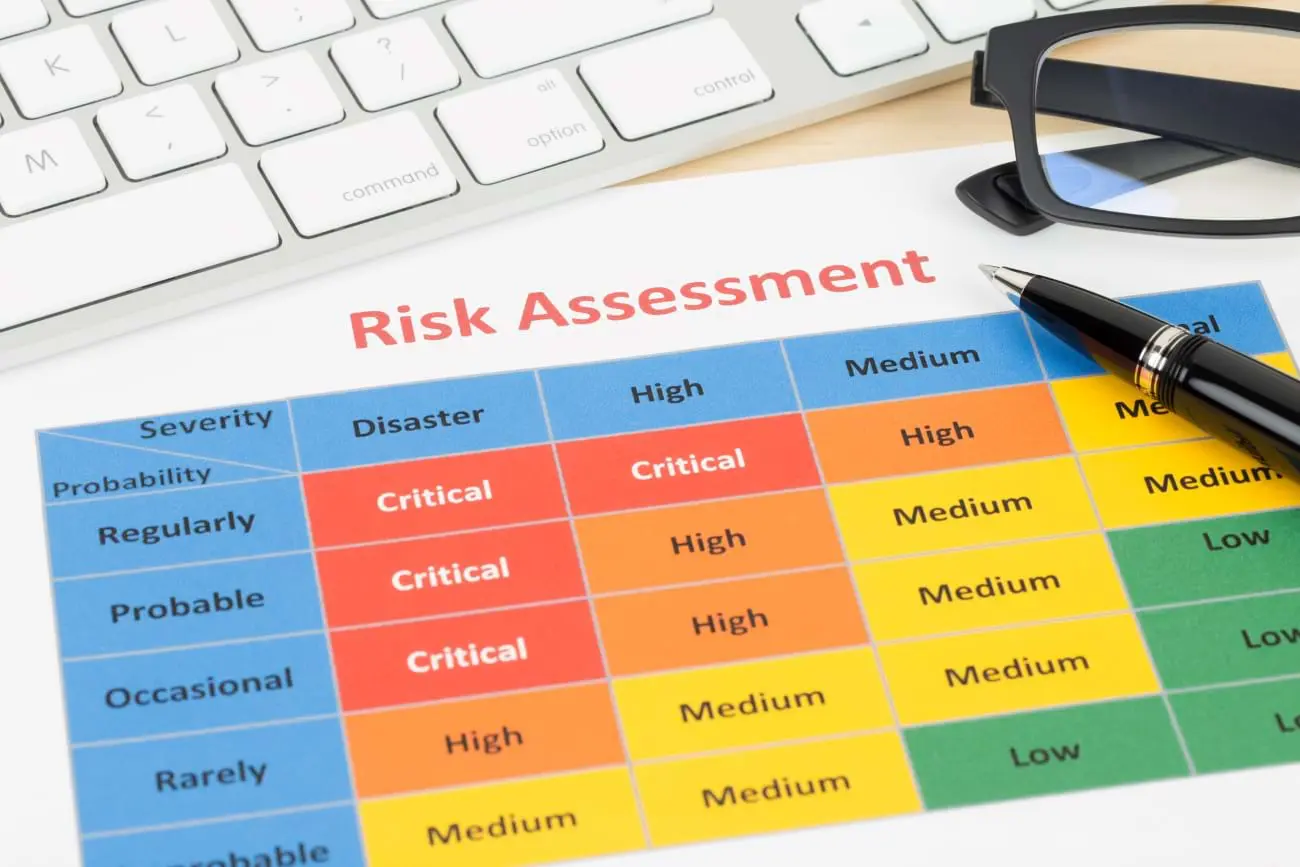According to the National Safety Council, there were more than 4.5 million medically consulted injuries that occurred in U.S. workplaces in 2022. That year, nearly 160,000 workers were impacted by workplace injuries—with nearly 4,700 preventable injury-related deaths.
Those sobering numbers are a stark reminder of the importance of workplace risk management. Workplace hazards are all too common, particularly in industries like construction, transportation, warehousing, and manufacturing. Yet with the right workplace risk management programs and processes, dangers in the workplace can be significantly mitigated and, in many cases, eliminated.
In this blog, we’ll cover the importance of workplace risk management in ensuring a safe and efficient work environment. We will address workplace risks, risk management best practices, legal and regulatory considerations, and more. Most of all, we’ll show why it’s crucial for businesses of all sizes to implement risk management practices to protect their employees and assets.
Table of Contents
What is Risk Management in the Workplace?

Workplace risk management involves processes that employers use to identify, assess, and mitigate potential risks or hazards to their employees. The goal is to maintain a healthy and safe working environment for all employees.
Understanding the Basics of Risk Management
A good risk management program is focused on identifying, analyzing, evaluating, and proactively addressing risks before they become a threat to employees. Assessing risk is a systematic and detailed process in which organizations carefully consider all potential risks to employees, including items or machinery that could cause harm, hazardous substances that could pose a threat, and even situations that could adversely affect the mental health of employees.
Many businesses use workplace risk assessment templates and other tools that allow organizations to identify, analyze, and prioritize risks. These forms allow companies to document and evaluate all risks within their workplaces. Risks are prioritized by risk level, likelihood of injury, injury severity, and so forth. The templates give businesses a checklist they can use to tackle all risks, from highest to lowest priority, before they become dangers.
Types of Risks in the Workplace
There are many types of workplace hazards that can be found in different businesses and industries. Here are some of the most common dangers in the workplace:
- Health hazards. Health hazards could include hazardous substances, including chemicals, poor air quality, ergonomic issues, or threats to a person’s mental health, including work overload or the inability to achieve a proper work/life balance.
- Operational hazards. These are risks caused by equipment failure, human error, workplace violence, process management failures, and so forth.
- Physical hazards. Physical hazards include faulty equipment, loud noises, electrical shortages, etc.
Strategies for Effective Risk Management

There are several practices companies should adopt to ensure a safe and healthy workplace free of risks and hazards, including:
- Create emergency response plans. These are plans that detail how organizations will react in case of an emergency, including the proper steps to mitigate and contain potential damage. Examples include plans designed in response to a natural disaster (fire, flood, etc.) or unnatural disaster (chemical spill, etc.). Emergency response plans should include a list of responsibilities for all parties, communications protocols, evacuation routes and procedures, and more.
- Perform regular safety inspections. Routine safety inspections can help discover possible workplace dangers, allowing teams to rectify them before they become problematic. It’s often a good idea to bring in outside third-party inspectors, who can provide an unbiased assessment of workplace conditions.
- Safety inspections aren’t just good for the health and wellbeing of employees, they’re also important for compliance of federal law. The Occupational Safety and Health Act requires employers to make, keep, and preserve accurate safety records and present them to federal officials upon request. These accounts can be compiled through regular inspections.
- Train employees. Training employees on potential workplace dangers and proper safety procedures, including the use of equipment, is essential to maintaining a safe working environment. With the right training, employees will be equipped to identify and know what to do (or what not to do) with a potential hazard. They can more easily and correctly prevent and respond to workplace risks.
- Take preventative measures. There are other things organizations can do beyond identifying and assessing possible threats and creating workplace risk assessment templates. For example, they can provide employees with the proper safety equipment, such as face masks, gloves, goggles, earplugs, and more.
Learning from past experiences is another valuable tool that can help avert future risks. Businesses should thoroughly investigate accidents that occur, assess what took place, and implement actions that prevent such an event from happening again. This will help ensure continuous risk management and improvement.
Implementing Risk Control Measures
Developing and implementing effective risk control measures is critical to workplace safety. Without the right control measures in place, dangers in the workplace can easily go unchecked. Employees health and safety may be put at risk, and organizations may end up being non-compliant with safety regulations.
Risk Management Process
Implementing the correct risk management process is the key to good risk control. An ideal risk management process includes five steps:
- Identifying risks
- Analyzing risks
- Evaluating and prioritizing risks
- Addressing risks
- Continuously monitoring risks
A key component of risk control is the risk assessment. This is the phase in which organizations carefully seek out, document, analyze, evaluate, and prioritize risks. Understanding the hazards present in a workplace is the first step toward taking control and minimizing those hazards.
Leveraging Technology in Risk Management
Technology can help enhance workplace risk management efforts. With the right technology, companies can automate compliance checks, document risk management practices and safety measures, monitor regulatory compliance laws and regulations, and more.
Here are six technologies to consider:
- Compliance and risk management software. Compliance and risk management software is used to continuously track and monitor companies’ adherence to safety rules and regulations. The software can automatically check current workplace risk management practices against current and new regulatory requirements to ensure businesses remain in compliance. Companies can also use this technology to generate reports that can be used both internally and externally (for example, for OSHA reporting).
- Wearable technology. Wearable technology includes sensors embedded into workers’ clothing or uniforms. The technology monitors a person’s physical response to their environment, including oxygen level, pulse rate, etc. It also allows companies to monitor a worker’s proximity to a potential workplace hazard.
- Equipment sensors. Similar to wearable technology, equipment sensors connected to machinery monitor the machine’s performance. If a machine malfunctions, the sensors will emit an alarm that alerts management to the incident, allowing them to shut down the machine before it poses a health threat to workers.
- Data analytics. Companies can use data analytics to analyze their safety data. Data can be collected through incident reports, safety inspections, and more, and analyzed to uncover trends and potential safety concerns. Organizations can use this information to identify previously unknown workplace risks and improve their safety processes.
- Virtual reality. VR can be used for training simulations that put employees in the center of a simulated emergency. They can practice safety procedures and learn how to mitigate a potential hazard.
- Drones. Drones can detect workplace risks in places that humans might not be able to investigate, or where it might be too dangerous to do so. For example, construction companies might use drones to evaluate the safety of a construction site from the air. Drones can also monitor environmental factors, such as air quality.
Legal and Regulatory Considerations
In 1970 the U.S. Congress issued the Occupational Safety and Health Act, designed to “assure safe and healthful working conditions.” The Act requires organizations to adhere to several standards and requirements. Compliance requires different actions, including:
- Inspecting the workplace for possible hazards
- Eliminating or minimizing hazards
- Maintaining detailed records of workplace injuries and illnesses
- Educating and training employees to recognize health and safety issues
Failure to adhere to OSHA standards and requirements can result in hefty fines and violations and even criminal prosecution. OSHA fines organizations $16,131 for each serious violation, and $161,323 per violation. Several states operate their own worker safety initiatives and can also impose fines on top of OSHA’s.
OSHA also protects workers’ rights to a safe workplace. Per OSHA, all workplaces must be free of known health and safety hazards and workers have the right to speak up about hazards without fear of retaliation. A full list of workers’ rights can be found here.
FAQs

-
What is risk management in the workplace?
Risk management in the workplace is a set of actions organizations take to ensure their workplaces are free of hazards that could pose a threat to employees. A typical risk management process involves identifying, analyzing, evaluating, prioritizing, addressing, and monitoring risks.
-
How do you mitigate employee risk?
Mitigating risks to employees starts with performing an in-depth risk assessment, where all potential hazards in a workplace are identified, assessed, and prioritized in terms of their risk level (from highest to lowest risk). Once companies have performed the assessment they can begin proactively addressing the risks and fixing any potential issues, thereby mitigating employee risk.
-
What are the four risk management strategies?
Four of the most important risk management strategies include creating emergency response plans, performing regular safety inspections, training employees, and taking preventative measures.
-
How do you do a risk analysis?
To perform a risk analysis, organizations should identify possible risks, assess the likelihood of the risks occurring, and consider the potential damage that could be caused. Risks can then be prioritized according to their likelihood of occurring and their potential for damage and cataloged on a workplace risk assessment template.
Prioritizing Safety and Efficiency Through Risk Management
Proactive workplace risk management is essential to keeping employees safe, happy, and healthy. Implementing a comprehensive risk management program allows businesses to identify, analyze, and remediate all manner of dangers in the workplace, including health, physical, and operational hazards. By taking action, organizations can protect their workers and remain in compliance with national and state laws and regulations.
Acuity understands the intricacies of workplace risk management and can help your organization create a plan that works for your business and employees. Learn more about our risk management services and contact us to discuss how we can help your organization remain a healthy and safe environment.
